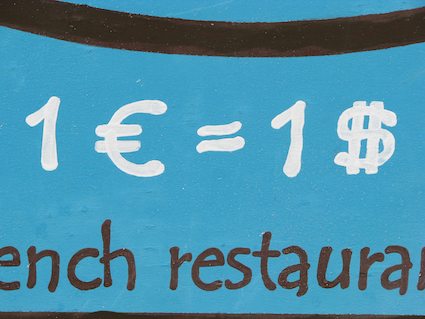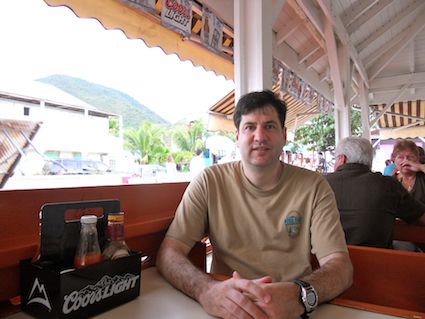I led-off with Saint Martin geo-oddities as one would expect on Twelve Mile Circle. However, with that obligation safely behind me I can now begin to act more like a “normal” tourist, or as close to normal as I can muster. I’m not typical when it comes to holiday travels, as you’ve undoubtedly learned while following this blog, but I can relax in a more recognizable tourist fashion when necessary. So that’s what you’ll get here today.
More Bang for the Buck

Dutch Sint Maarten uses the Netherlands Antillean Guilder — this will switch to the Caribbean Guilder in 2012. On the other hand, French Saint-Martin uses the Euro as it official currency. Even so, they seem mere formalities within the island’s tourist universe. The U.S. Dollar reigned supreme just about everywhere here. I’ve yet to see an actual Guilder anywhere. I suppose they exist but even the ATM’s spit-out U.S. Dollars on the Dutch side.
Back on the French side, in the village of Grand Case in particular we found that many businesses offered the best exchange rate imaginable: they accepted Dollars and Euros equally. The catch is that buyers have to pay in cold hard cash. Credit cards transactions still happened in Euros.
It makes a huge difference when paying 70 US Dollars for something priced nominally at 70 Euros. That works out to $70 vs. ~$100 at today’s exchange rate. I’ll take that trade any day of the week! I get the distinct feeling that businesses on the French side calculate their margins based on dollars. If someone is silly enough to pay in Euros then it’s considered a really, really nice tip. We dash across the nearby border to the Dutch side when our stash of dollars starts to run low and we lock everything but what’s necessary for the moment in the apartment safe.
I’m not sure what I’m going to do with the Euros I brought with me other than save them for a future trip to continental Europe. There’s no incentive to use them here.
On the Beach

Let’s get this out of the way. Yes I went to the beach. The most famous beach, the one always mentioned on tourist sites as one of the best in the Caribbean, sits on the eastern side of the island at Orient Bay. It’s French so clothing options or lack thereof benefit from more liberal interpretations than one would expect in many other parts of the world. For the record, we remained on the clothed side of the beach, thank you very much. I wouldn’t want to terrify anyone.
We also learned to keep our field of vision pointed towards the northeast after catching inadvertent glimpses of geriatrics wandering directly up to the boundary of the clothing optional section towards the south, separated only by a line of large stones. It may be the only time in my life that I didn’t want to explore a border. I’m no prude and if someone’s into that lifestyle then I’m fine with it. But it wasn’t like the folks strutting about like peacocks had the bodies of Olympic athletes either.
OK, I think a morning and lunch at this particular beach is enough. Can I leave now?
Îlet de Pinel / Pinel Island

Pinel Island was much more aligned with my lifestyle. It also has a beach. However, it’s part of a protected marine reserve and it’s much further removed from the crowds. One can only get there by boat. Little wooden vessels leave from nearby French Cul-de-Sac throughout the day charging a few bucks round-trip. It’s a short ride, maybe ten minutes or less, but I suppose it’s enough of a hassle to keep most of the hordes away.
There are a small number of open-air beachside restaurants along the island’s small sandy waterfront. Most people remain here under beach umbrellas while servers deliver fruity frozen drinks for hours at a time. Others head over to the snorkeling area. That idyllic lifestyle appeals to most visitors but I had to get up eventually and wander around. The park includes hiking trails and it’s a quick walk over and around the island. There I discovered two very nice rustic beaches completely devoid of visitors. It felt like I’d found my own deserted isle.
Marigot

We don’t normally travel to tourist-infused locations so sometimes it’s been a bit of an adjustment. At lunch in Marigot we sat at an outdoor cafe and played a game of “guess who’s going to get their belongings snatched first.” Swarms of buses converged on the Marigot market unloading herds of cruise ship passengers, wearing expensive jewelry, dangling cameras, lugging big floppy purses, and generally ignoring even the basic rules of safe travel by paying absolutely no attention to their belongings or their surroundings. It would be a pickpocket’s dream.
We never observed anything unsavory, but a lot of the online guides and reviews warned against petty crimes of opportunity. We wondered if those might have been rooted in people’s carelessness and inattentiveness in crowded marketplaces. The online reviews create an unwarranted climate of apprehension in my opinion. Take normal precautions and everything should be fine. This is a safer place than my home neighborhood in the United States.
We then climbed up to Fort St. Louis at the base of the Marigot harbor for spectacular views of the island. Fort St. Louis was constructed in the 18th Century to protect French interests there. Today its ruins have become a popular tourist attraction. You can just see it at the top of the hill in this photo.
Lolos

I love the “lolo” restaurants, the outdoor barbecue shacks where diners get more Creole-inspired cuisine than one can possibly eat in a single sitting, for about ten bucks. These are a great counter-balance to the extremely expensive French restaurants that are considerably more formal, although we’ve enjoyed those as well. Oxtail stew, curried goat or simply-grilled fish at a lolo for lunch and haute cuisine for dinner. You’ve heard me describe myself as low-brow and high-brow simultaneously with nothing in between? Well, those are the primary dining choices on the French side. I’m in food heaven.
I guess my time on St. Martin is quickly coming to an end. Darn. It’s been a lovely holiday.

Leave a Reply